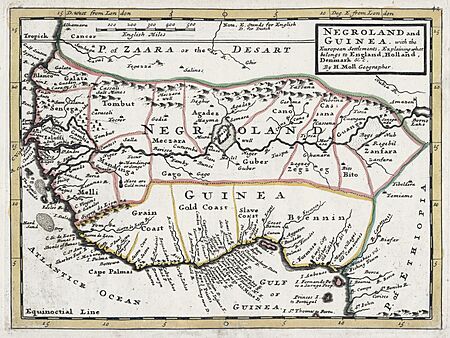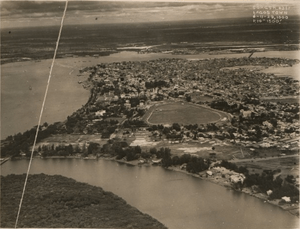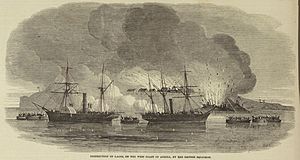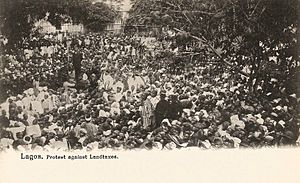History of Lagos facts for kids
Lagos is the biggest city in Nigeria and used to be its capital. It's the largest city in Africa by population, with about 15.3 million people. Lagos also has the 4th largest economy in Africa. The city was started in the 16th century by the Awori people and was called Eko. For many years, it was a small but important trading kingdom near the Bight of Benin. In 1851, the British got involved in a local political disagreement and started to have influence. Lagos officially became a British protectorate in 1861.
Contents
Past Names of Lagos
The main part of modern Lagos, Lagos Island, was first called 'Oko' by the native Awori people, who are a part of the Yoruba people. Later, it was known as 'Eko' when the Benin Kingdom ruled it. The name 'Eko' came from Ikurame, which means 'war camp' in the Edo language. The Portuguese explorers called it "Onim" and then "Lagos".
The name Lagos means "lakes" in Portuguese. A Portuguese explorer named Rui de Sequeira visited the area in 1472. He named the area around the city Lago de Curamo, which means Lake of Curamo. It's also possible the city was named after a coastal town in Portugal called Lagos, Portugal, where many sailors and settlers came from.
How Lagos Began
Founding Story
The Awori people, a group of the Yoruba people, were the first to live in Lagos. An Awori story says that their leader, Olofin, was given a mud plate by Oduduwa. He was told to put it in the river and settle wherever it sank. The plate floated down the river and finally sank in Lagos lagoon. Olofin then divided the island among his ten sons. One son, Aromire, planted pepper on the nearby island of Lagos. The palace of the Oba (king) of the Yoruba, Iga Idunganran, was later built there. Its name means "pepper farm palace."
Early Days
The first people living near the lagoon were fishermen. The Awori arrived by the 15th century, coming down the Ogun river to find safety from a war. The beginnings of Eko were at Isheri, where Ogunfunminire of Ife became the first king. As trade grew across the lagoon, the main center moved to Ebute-Metta, then Iddo, and finally to Eko island. Those who crossed the lagoon to farm Lagos Island were still under the rule of the Olofin, the king of Iddo.
Many groups came to the area for trade. These included the Ijebu in the 15th century and the Binis in the 16th century. The Portuguese started trading in the lagoon around 1500. They usually went directly to Ijebu, bypassing the small island communities.
Under Benin's Rule
By the mid-16th century, the Kingdom of Benin was becoming more involved in European trade. It was expanding west to control more coastal trading spots. Around 1600, a disagreement happened between the Beninese and other foreign traders and the local Awori people. This gave Benin a chance to increase its power. Oba Orhogbua attacked Iddo, but the Olofin and the Awori fought him back. Eventually, the Benin armies won, or a peace agreement was made. Lagos Island became a strong military post for Benin. Its commander, Asheru, had a lot of influence in the area, especially among non-Awori traders.
The fighting continued, and Asheru was killed during a raid. An Awori chief named Ashipa wanted to secure his position. He returned the commander's body to Benin city. The Oba of Benin then made him the ruler of Eko. Ashipa started a new royal family that would eventually take the title Oba. He also began a payment of tribute to Benin, which lasted until 1830. However, Eko's connection to Benin became less strong by the 18th century.

Trade Growth and Changes
A Major Trading Port
The presence of Benin's military and trade with European merchants helped Lagos grow economically. People from along the coast and further inland came to Lagos Island to trade. At this time, cloth was the main item sold and sent out from the island. In the 17th century, trade with the Portuguese also increased. Onim became a center for the trade in people. The local obas (kings) had good relationships with the Portuguese. In 1652, English traders made the first recorded purchase of people for forced labor in Lagos.
However, Lagos did not become a very important port for this trade until the 1760s. A story says that a disagreement with his brother Gabaro sent Prince Akinsemoyin away to Badagry. There, he met European traders. When Akinsemoyin became king of Eko in the 1760s, he opened his kingdom to the trade in people. This trade grew a lot in the 1780s. It grew even more with Dahomey's wars and the collapse of the Oyo Empire in the early 19th century. By then, Eko was the largest exporter of people in the northern part of the world. Like many West African states, it built strong connections with South America. It sent representatives to the Portuguese colony of Brazil and was one of the first countries to recognize Brazil's independence in 1823.
King Succession Disputes
Akinsemoyin passed away around 1775. He was briefly followed by Eletu Kekere, and then by Ologun Kutere around 1780. When Ologun Kutere died around the early 1800s, his sons Osinlokun and Adele Ajosun argued over who would be king. Osinlokun was the older son and rightful heir, but Adele was crowned instead. This might have been because he was his father's favorite. Adele made some changes and allowed Islam into the kingdom, which caused problems with the chiefs. A civil war started, and Adele and his supporters had to leave for Badagry. He kept trying to take back Lagos from 1821 to 1835 but could not.
When Osinlokun died in 1829, his son Idewu Ojulari became king. However, he became unpopular because he was greedy, possibly due to a slowdown in the trade in people. The chiefs told the Oba of Benin, who was still the ruler in name. The Oba sent Idewu a skull and a sword, telling him that the people of Lagos no longer wanted him as king. Idewu understood this as a command to take poison or a threat, so he ended his own life.
Idewu Ojulari's brother Kosoko was stopped from becoming king by the Eletu Odibo. This official was in charge of choosing and installing kings. Their long disagreement had big effects on Lagos's history. Adele Ajosun was invited back to the throne but died two years later.
The Eletu Odibo again stopped Kosoko from becoming king. Adele's son Oluwole was crowned instead. When Kosoko's rich and powerful sister, Opo Olu, was sent away on false charges, Kosoko and his followers declared war on Oluwole and the Eletu Odibo. They lost and fled. Soon after, Oluwole died when lightning caused an explosion in the palace. The new king, Akitoye, tried to bring peace by inviting his nephew Kosoko home and giving him titles. But he could not make peace between Kosoko and the Eletu Odibo, who went away to Badagry. Akitoye convinced him to return and allied with the Egba people as tensions grew. Kosoko, in turn, sought help from Dahomey and Ijebu.
When civil war broke out in July 1845, Kosoko's forces surrounded the royal palace for three weeks. The people inside had to drink salt water. This battle was remembered as the Ogun Olomiro (Salt Water War). Akitoye escaped to Abeokuta and then Badagry. However, the Eletu Odibo was captured and drowned.
British Influence
In the early 1800s, Britain fought against the trade of people across the Atlantic. Its West Africa Squadron chased ships involved in this trade and made agreements with West African chiefs to stop it. This created a strong British presence along the West African coast. In 1849, Britain appointed John Beecroft as Consul for the Bights of Benin and Biafra.
When Akitoye arrived in Badagry, he met with British officials and missionaries. The British saw a chance to help their interests in Lagos, where Portuguese and Brazilian traders were strong. They agreed to help Akitoye get his throne back. In 1851, Britain got involved in Lagos, an event known as the Bombardment of Lagos. This led to King Akitoye being put back on the throne and King Kosoko being removed. King Akitoye then signed the Treaty between Great Britain and Lagos in 1852, which officially ended the trade in people. This treaty started the Consular Period, where Britain provided military protection for Lagos.
The Royal Navy first used the port of Fernando Po (now Bioko, Equatorial Guinea) as a base. In 1855, Spain claimed this port. So, the Royal Navy needed a new base, and Lagos was the best choice.
Colonial Lagos
Because of threats from Kosoko and the French, British Prime Minister Lord Palmerston decided in 1861 that Britain should formally take control of Lagos. On July 30, 1861, British officials met with Oba Dosunmu. They explained Britain's plan and demanded a response by August. Dosunmu did not want to agree, but under threat of attack, he signed the Lagos Treaty of Cession on August 6, 1861.
Lagos as a Colony
Lagos was declared a colony on March 5, 1862. It was first governed by the Gold Coast (modern-day Ghana). In 1886, Lagos became a separate colony under Governor Cornelius Alfred Moloney. The port of Lagos became a very important trading center. Traders knew they could rely on the Royal Navy to protect them from pirates.
Lagos quickly became a place where many people moved. Along with people from all over Nigeria and other West African countries, former enslaved people returned. These "Creoles" came from Freetown, Sierra Leone, Brazil, and the West Indies. They helped modernize Lagos, and their knowledge of Portuguese architecture can still be seen in buildings on Lagos Island. Since the 19th century, Lagos has become a mix of African and European cultures.
In 1869, the Cathedral Church of Christ was built in Lagos. Five years earlier, Samuel Ajayi Crowther became the first African bishop of the Anglican Church.
Lagos as Capital
Lagos became very important for Nigeria because of General Lugard. After 1900, he moved British troops far north. As governor, he made Lagos the capital of southern Nigeria and later of the whole country.
In 1906, Lagos joined the Protectorate of Southern Nigeria and became its capital. In Lekki, near Lagos, the Nigerian Bitumen Corporation found oil during test drilling in 1908.
On January 1, 1914, Northern Nigeria and Southern Nigeria were joined to form the "Colony and Protectorate of Nigeria". Lagos became the capital. However, the British ruled northern and southern Nigeria differently. In the north, they used "indirect rule", keeping traditional ruling systems mostly in place. In the south, like Lagos, the British ruled directly. They tried to bring European ideas to the local people. This included the "Nigerian Council" from the Clifford Constitution of 1922. This was a type of parliament with 46 representatives, including four locals, three of whom were from Lagos. Northern Nigerians were not included.
Modern Changes
The Lagos Government Railway started building a railway line from Lagos to Ibadan in 1896. It opened on March 4, 1901. The line was later extended to Nguru through Oshogbo, Ilorin, Kaduna, Zaria, and Kano. This made the total length about 1360 km. From 1902, the railway also ran the Lagos steam tramway.
Telegraph cables connecting Lagos to London were set up by 1886.
Electricity came to Lagos on September 19, 1898. The power line supplied the Lagos marina from the Government House to the north side of the island.
In 1901, the first bridge was built between Lagos Island and the mainland. It was called the Carter Bridge.
In 1913, the Lagos Port officially opened.
Epidemic
A major event in Lagos's history was the outbreak of bubonic plague. This disease started in 1924 and lasted until 1931. It caused 1,947 cases and 1,813 deaths.
Mailboat Connection
Since February 1, 1914, a regular mailboat service ran between Lagos and Great Britain (Liverpool). These mail ships were the main way Nigeria connected with Britain before air travel started in 1945. Once a month, a mail steamer from Liverpool docked in Lagos/Apapa. These ships carried letters, parcels, cargo, and about 100 passengers. They also stopped in Gambia, Sierra Leone, Liberia, and the Gold Coast (Ghana). This is how colonial officials, army officers, business travelers, and tourists reached the West African colonies.
By 1935, Nigeria's railway network was at its largest, with 3,056 km of track. A railway bridge over the Niger River was built in 1916, and another over the Benue River in 1932. The maintenance workshop in Ebute Metta employed 1,500 local people. High school graduates could train there for six years to become locomotive drivers or technicians. They were paid during training and earned a good salary after finishing. The railway company even provided a working steam locomotive for trainees in Lagos to learn on.
Second World War
In 1942, British special agents used Lagos ports to hold Italian and German supply ships. These ships were captured during "Operation Postmaster". This event almost caused Spain to join the war with Germany and Italy.
In June 1945, railway workers in Lagos started a nationwide general strike. It was the first of its kind in Nigeria, growing to include 200,000 workers and seventeen labor unions. In 1946, a commission increased workers' wages. The strike highlighted problems with British rule in Nigeria. It is seen as a "turning point" in Nigerian labor relations.
Independence and Growth
Lagos remained the capital when Nigeria became independent from Britain in 1960. Lagos grew very quickly throughout the 1960s and 1970s because of Nigeria's economic boom. This growth continued through the 1980s and 1990s and up to the present.
Divided into LGAs
Before May 27, 1967, Lagos was managed directly by the Federal Government. The Lagos City Council (LCC) governed the city. Lagos, along with towns from the Western region (Ikeja, Agege, Mushin, Ikorodu, Epe, and Badagry), were combined to create Lagos State. Lagos city was divided into seven Local Government Areas (LGAs). The other towns now make up 13 LGAs in the state. Lagos was both the State and Federal Capital until 1976 when the state capital moved to Ikeja. Lagos faced challenges during Nigeria's military rule.
Music Industry and "Band on the Run"
Lagos has been a major center for the music industry since the 1970s. International stars like Beyoncé have recorded songs in Lagos.
Paul McCartney, formerly of The Beatles, was a pioneer in this. He recorded the album "Band on the Run" with his band Wings in Lagos in 1973. He hoped the unique location would inspire him. "Band on the Run" is still McCartney's most successful album and is highly praised.
The Cement Armada
One unusual event in Lagos's history was the "cement armada." In 1974, due to problems with the government, hundreds of ships carrying cement were stuck outside the port. This caused a lot of chaos.
Volkswagen Plant
Volkswagen of Nigeria started assembling cars in Lagos on March 21, 1975. In 1976, it produced over 16,000 vehicles. In the 1980s, import restrictions made production difficult.
In 1990, Volkswagen decided to leave Nigeria. Negotiations to sell to a Nigerian company failed. In 1994, Volkswagen removed its last German employees. Production has stopped since then. The area where the factory was located is still called "Volkswagen."
FESTAC 77
From January to February 1977, the Second World Black and African Festival of Arts and Culture (FESTAC) took place in Lagos (and Kaduna). FESTAC 77 is thought to be the largest cultural event in Africa in the 20th century. It included events and exhibitions on African art, film, music, literature, dance, and religion. The area where it happened is still called "Festac town" today.
Visit of Jimmy Carter
From March 31 to April 3, 1977, then-US President Jimmy Carter visited Lagos. As of 2025, it is the only visit by a US president to the city.
No Longer Nigeria’s Capital
In 1991, Ibrahim Babangida, the Military President, and other government offices moved to the newly built capital, Abuja. This change caused Lagos to lose some of its importance and economic power. However, Lagos remains the financial center of the country. It has also grown to be the most populated city area in Nigeria.
New Millennium
The Rise of Nollywood
After 2000, the Surulere district became the center of the Nigerian film industry, known as Nollywood. Lagos itself has been the setting for many films. The 2016 film "Captain America: Civil War" has a scene set in Lagos. Other international shows and films have also used Lagos as a filming location. The film "93 days" (2016) is a true story about the 2014 Ebola outbreak in Lagos and was filmed there. Nigerian films have focused on high-quality productions that are also successful. This has led to new box office records in Nigeria.
Emergency Situations
On January 27, 2002, explosions happened at a barracks in the city. A fire from a street market spread, causing about 30 explosions in an ammunition depot. This affected nearby buildings. People fled in fear. The disaster caused at least a thousand deaths. Many families lost their homes. The explosions affected areas up to seven kilometers away. Many children drowned in a sewer while trying to escape.
In 2012, 163 people died when a McDonnell Douglas MD-83 plane crashed into a furniture workshop and printing press building.
On November 1, 2021, a 21-story building being built in the rich Ikoyi area collapsed (full article here). 44 people died, including the owner and construction manager. Witnesses said a pillar on the first floor had cracks. The owner, Femi Osibona, asked the contractor to replace it. Soon after, the building collapsed. The building permit only allowed 15 stories, and the original contractor had left the project a year earlier because of changes to the building plan. This construction disaster is the largest of its kind in Lagos.
Ebola in Lagos
On July 20, 2014, a traveler from Liberia with Ebola arrived at Lagos airport. He was diagnosed after being admitted to a private hospital. This patient may have infected 72 people at the airport and hospital. The patient died on July 25. By September 24, there were 19 confirmed Ebola cases. No new cases had appeared since August 31, suggesting the outbreak in Nigeria was contained. A quickly set up Emergency Operations Centre helped control the outbreak early and avoid a disaster.
Tech Hub and Zuckerberg Visit
On August 30, 2016, Mark Zuckerberg visited tech startups in the Yaba district. He spoke to children learning programming languages during their summer holidays. In October 2017, Facebook created the first African SME Council in Nigeria to support small and medium-sized businesses.
Infrastructure Projects
On June 10, 2021, Lagos got a standard gauge railway link to Nigeria's third-largest city, Ibadan. This included a modern central station, Mobolaji Johnson. Nigeria is expanding its rail network with help from China. In 2022, the Nigerian Railway Corporation reported that the Lagos-Ibadan line was profitable despite restrictions from the Covid epidemic.
In January 2023, the new deep-sea port of Lekki opened. This helps reduce traffic at the older, more crowded ports of Apapa and Tin Can Island.
On September 4, 2023, the first part, the blue line, of the Lagos suburban railway started operating.
On February 14, 2024, Governor Sanwo-Olu announced that the Red Line of the Lagos suburban railway would open on February 29, 2024.
New Multi-Purpose Arena
On February 24, 2024, construction began on Victoria Island for a multi-purpose arena. It will seat 12,000 people and be a stage for the growing entertainment industry. Several companies are working together to build the arena, which is expected to be finished by December 2025. The arena will host many events, from international music stars to family shows, basketball, and boxing. It aims to be Africa's top venue for live entertainment, hosting 200 events a year.
Obas (Kings) of Onim / Lagos
- Ashipa (1600–1630)
- King Ado (1630–1669) first King of Lagos
- King Gabaro (1669–1704)
- King Akinsemoyin (1704–1749)
- Eletu Kekere (1749)
- King Ologun Kutere (1749–1775)
- Adele Ajosun (1775-1780 & 1832-1834)
- Eshilokun (1780–1819)
- Oba Idewu Ojulari (1819–1832)
- King Oluwole (1836–1841)
- King Akitoye (1841-1845 & 1851-1853)
- Oba Kosoko (1845–1851)
- King Dosunmu [Docemo] (1853–1885)
- Oba Oyekan I (1885–1900)
- Oba Eshugbayi Eleko (1901-1925 & 1932)
- Oba Ibikunle Akitoye (1925–1928)
- Oba Sanusi Olusi (1928–1931)
- Oba Falolu Dosunmu (1932–1949)
- Oba Adeniji Adele (1949–1964)
- Oba Adeyinka Oyekan II (1965–2003)
- Oba Rilwan Akiolu (2003–present)
See also
- Timeline of Lagos
- Oba of Lagos









